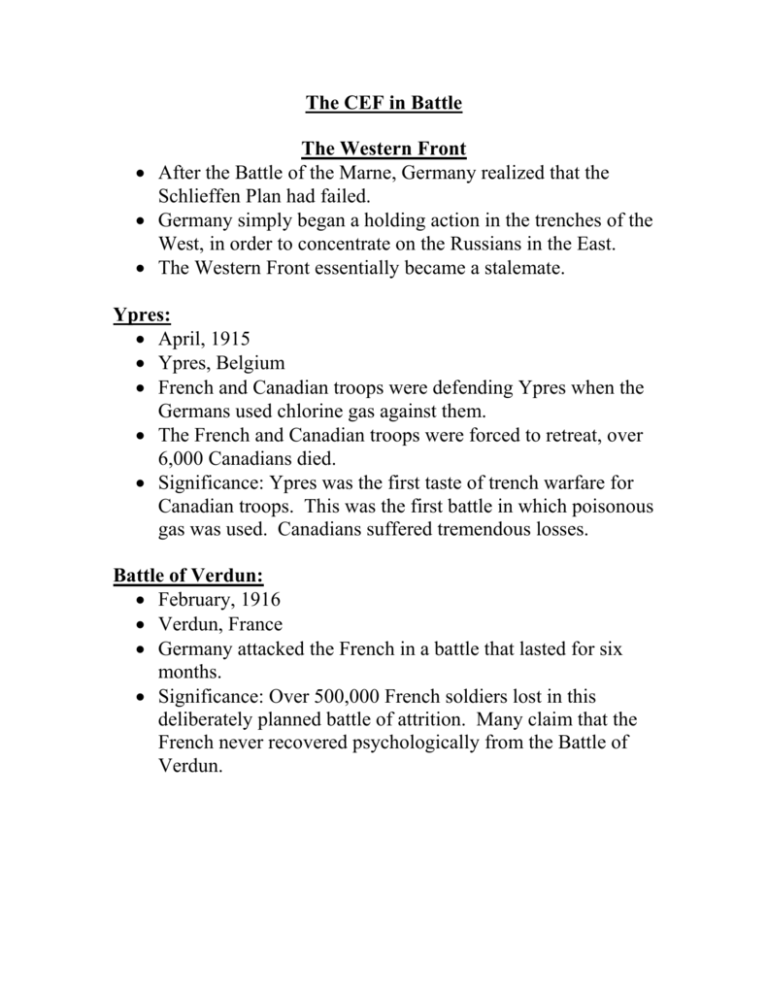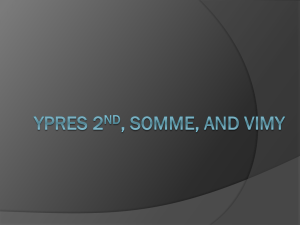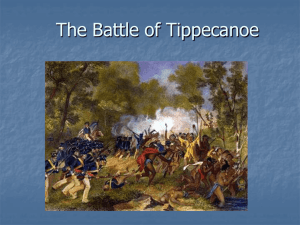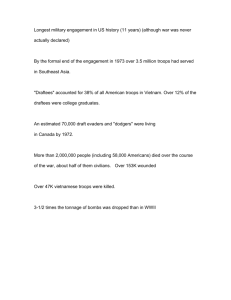The CEF in Battle
advertisement

The CEF in Battle The Western Front After the Battle of the Marne, Germany realized that the Schlieffen Plan had failed. Germany simply began a holding action in the trenches of the West, in order to concentrate on the Russians in the East. The Western Front essentially became a stalemate. Ypres: April, 1915 Ypres, Belgium French and Canadian troops were defending Ypres when the Germans used chlorine gas against them. The French and Canadian troops were forced to retreat, over 6,000 Canadians died. Significance: Ypres was the first taste of trench warfare for Canadian troops. This was the first battle in which poisonous gas was used. Canadians suffered tremendous losses. Battle of Verdun: February, 1916 Verdun, France Germany attacked the French in a battle that lasted for six months. Significance: Over 500,000 French soldiers lost in this deliberately planned battle of attrition. Many claim that the French never recovered psychologically from the Battle of Verdun. Battle of the Somme: July, 1916 Somme, France Allied commanders tried to end trench warfare with a large attack on the German trenches as the Somme. The Germans were not driven back and over 20,000 Canadians were killed. Significance: Casualties for both sides reached 1.25 million. When the battle ended five months after it began, only a few miles of land had been gained. The Newfoundland Regiment suffered 90% casualties. 23 Canadian men were executed because they would or could not return to the front. Vimy Ridge: April, 1917 Vimy Ridge (between France and Belgium) The ridge had fallen to German soldiers in 1914. Canadian troops tried to regain the ridge after British and French troops had failed to affect a breakthrough. The Canadians were successful, although over 3000 were killed and 7,000 were injured. Significance: Vimy Ridge was the first time that Canadian units fought together as one, and this victory became a symbol of Canada’s independence. As a result of the victory, Canadian troops also became recognized as some of the best troops on the Western Front. Passchendale: October, 1917 Passchendale, Belgium Canadian troops were asked to attack the Germans Canadians gained 7km of land and held their position until reinforcements arrived. However, the Germans soon gained back their lost land. Significance: The objection of the Canadian Commander, General Arthur Currie was overruled and his troops were forced into battle. Many Canadian soldiers lost their lives: only one in five survived. In the end, the battle proved futile as the Germans soon won back their land. The Eastern Front While Canadian troops did not participate in the Eastern Front, the events on this front are important to the outcome of the war. The Russian Campaign, August 1914-1916: By August 1914, Russian troops were invading Germany. Though surprised by the speed in which the Russians reacted to the declaration of war, Germany was able to defeat the Russians in a number of battles. However, German success against the Russians helped to contribute to the stalemate on the Western front by diverting much needed troops to the east. Gallipoli Campaign, April-December, 1915: The Ottoman Empire entered the war on the side of the Central Powers in an attempt to keep the Russians out of the straits of the Gallipoli peninsula (a water passage that would allow the Russians access to the Balkans and the Black Sea – an all weather port). The British also wanted control of the Gallipoli Peninsula in order to open a supply line and allow the British to attack AH and Germany from the Balkans. The result was nothing more than disaster and demoralization. Most of the troops fighting were Australian/Kiwis who suffered tremendous losses in this poorly planned attack.









